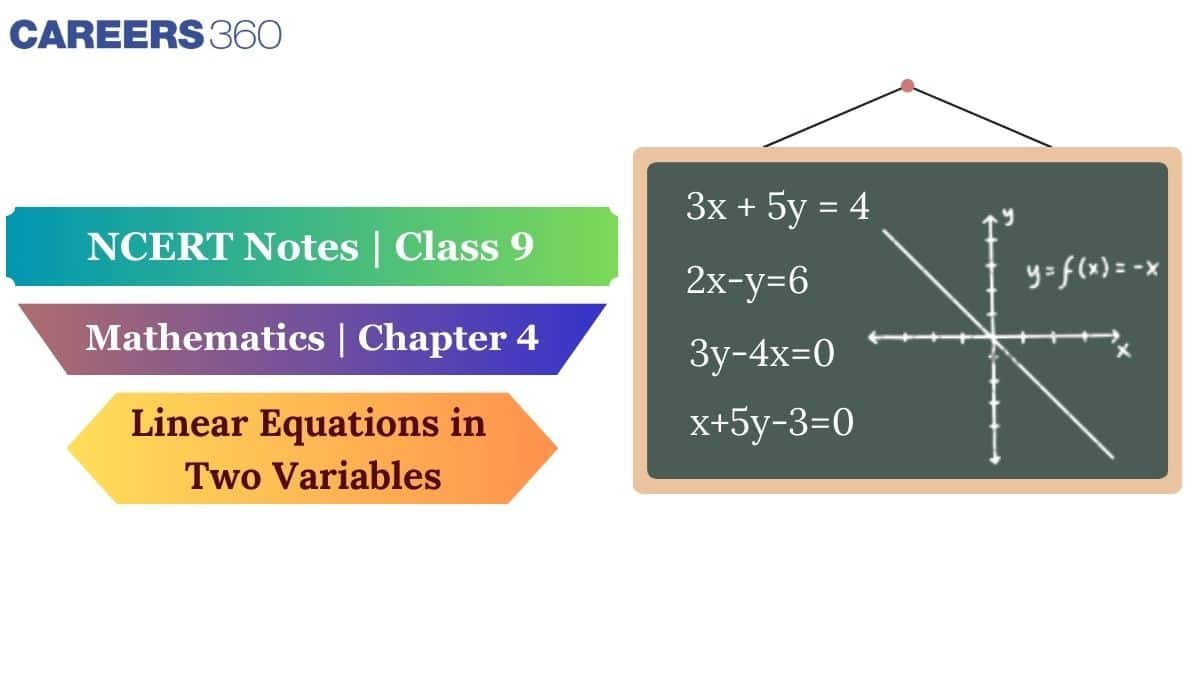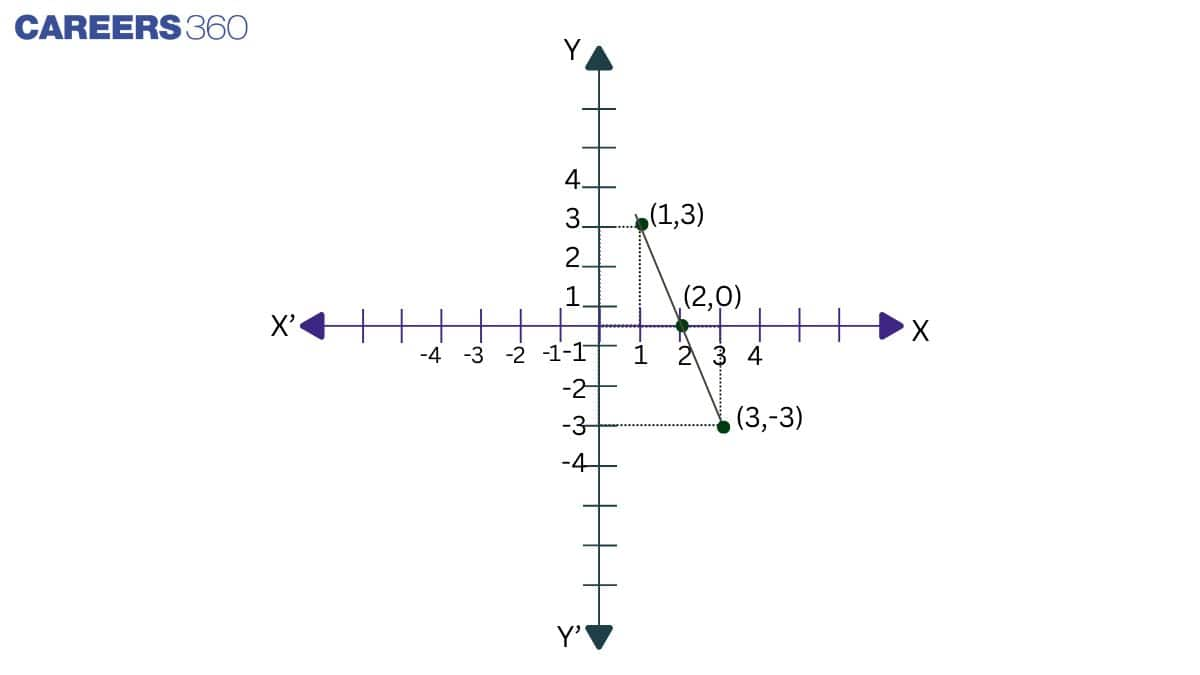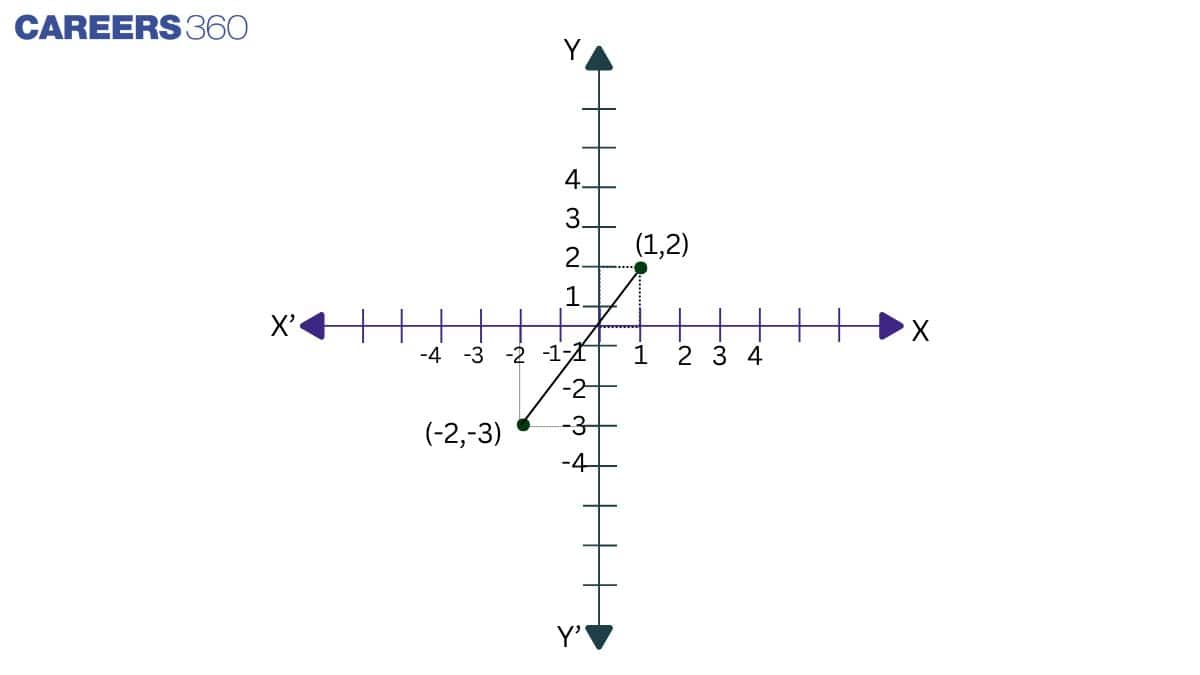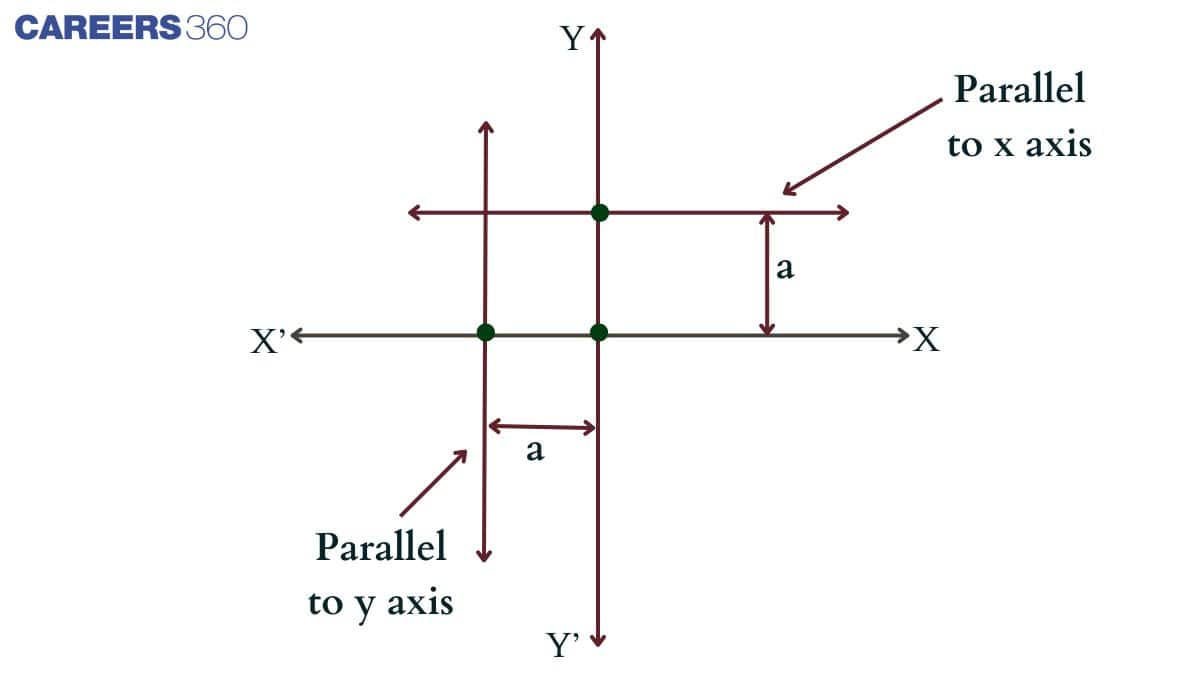NCERT Class 9 Maths Chapter 4 Notes - Linear Equations in Two Variables (PDF Download)
Why do we need two variables in one equation? Let’s explore and learn about linear equations in two variables. A linear equation in two variables is an important concept in mathematics. It helps to establish equations with two variables, and the relationship between these variables will be defined using mathematical operators such as addition, subtraction, multiplication, and division. This equation generally generates a straight line. Linear equations can have one, two, or more variables, but all variables must have a power of 1 and no multiplication between them. The degree of the variable is also known as an exponent. It helps to solve the mathematical problem by creating equations. It is used to calculate the distance, speed, and time of an object and helps to convert the problem into a mathematical equation. It is also used to solve geometry-related problems, such as lines and parabolas. The primary objective of these NCERT notes is to provide students with a valuable revision tool and reinforce their learning.
This Story also Contains
- Class 9 Linear Equations in Two Variables PDF – Download Free Study Material
- Linear Equations in Two Variables Class 9 Notes
- How to Use the Linear Equations in Two Variables Class 9 Notes Effectively?
- Linear Equations in Two Variables Class 9 Notes: Previous Year Question and Answer
- NCERT Class 9 Maths Notes – Chapter-Wise Links

These NCERT Class 9 Maths Chapter 4 notes explain what a linear equation is, including whether it involves one variable or two. Students will find simple definitions, examples, and step-by-step guidance on how to represent linear equations both algebraically and graphically in these notes. CBSE Class 9 chapter Linear equation in two variables includes all the topics and their examples in these notes. Students must practice all the topics of Linear equation and their examples from the NCERT Exemplar Solutions for Class 9 Maths Chapter 4 Linear Equation in Two Variables. Our Subject Matter Experts at Careers360 have designed these NCERT Class 9 Maths notes in an easy-to-understand language. Find everything in one place – NCERT Books, Solutions, Syllabus, and Exemplar Problems with Solutions – in this NCERT article.
Also, read,
Class 9 Linear Equations in Two Variables PDF – Download Free Study Material
Students who wish to access the Linear Equations in Two Variables Class 9 Maths notes can click on the link below to download the entire notes in PDF.
Linear Equations in Two Variables Class 9 Notes
Careers360 brings you NCERT Class 9 Maths Chapter 4 Linear Equations in Two Variables notes, carefully prepared by subject experts to simplify your studies and help in exams.
Linear Equations in One Variable: An equation that has one variable with a degree of one is called a linear equation in one variable.
The standard form of a linear equation in one variable is ax + b = 0, where a is not equal to zero.
Example: 2x + 3 = 0, 4x = 1
Linear Equations in Two Variables: An equation that has two variables with a degree of one is known as a linear equation in two variables.
The standard form of a linear equation in two variables is ax + by + c = 0, where a and b are not equal to zero.
Example: 3x + 2y = 5, 2a + 3b + 4 = 0
Establish a Linear Equation in Two Variables
The linear equation in two variables can be created by assuming the variables with the values as given in the example.
Example: The sum of the cost of a bat and a ball is 12. Write a linear equation in two variables to represent this statement.
Let the bat be represented by x and the ball by y.
According to the statements,
The equation is: x + y = 12
Solution of Linear Equations in Two Variables
The linear equation in two variables has two variables, which consist of two numbers and are known as the solution of the linear equation in two variables.
Some points related to the solution of linear equations in two variables:
1. Solution can be determined by the assumption method, and according to this method value of one variable is assumed, and this variable is replaced with this value and proceed to find the solution for the other variable is found.
2. There are many possible solutions for the same linear equation in two variables.
Graphical Representation of a Linear Equation in Two Variables
For any linear equation ax + by + c = 0, the pair of solutions in the form of variables (x, y) can be represented in the coordinate plane. With these coordinate values, the line doesn't always need to cut the coordinate axes.
Example: Write four solutions for the equation 3x + y = 6.
| Value of x | Replacing the Value of x in the Equation | Value of y | (x, y) |
| X = 1 | 3(1) + y = 6 | 3 | (1, 3) |
| X = 2 | 3(2) + y = 6 | 0 | (2, 0) |
| X = 3 | 3(3) + y = 6 | -3 | (3, -3) |
The graphical representation for the given coordinates is as follows,

Important Points:
1. Every coordinate in the graphical representation is the solution of a linear equation.
2. In a linear equation in two variables, when any number is added, multiplied, divided or subtracted from both sides of the equation, then the equation will be unaffected.
Lines Passing Through the Origin
When a linear equation has a solution coordinate (0, 0), and if these coordinates are represented in the coordinate plane, then these points pass through the origin, as shown in the figure:

Lines Parallel to the Coordinate Axes
A line is called a parallel line to the x-axis if the equation is in the form of y = a, where a is the distance of the line from the x-axis and a is a constant value. Similarly, A line is called a parallel line to the y-axis if the equation is x = a, where a is the distance of the line from the y-axis and a is a constant value.

How to Use the Linear Equations in Two Variables Class 9 Notes Effectively?
Linear equations in two variables become easy when we understand what an equation means and how its solutions form a line on a graph. This chapter mainly teaches us how to write equations and find their solutions clearly. Class 9 Maths chapter 4 notes help us to revise these concepts. Here are some more points on how these notes are important.
- First, review the basics of linear equations and examine simple examples to understand how two variables work together.
- Practise solving equations and drawing their graphs so we get used to finding solutions step by step.
- Keep the NCERT Class 9 Maths chapter 4 notes with you while doing textbook questions to check steps and correct your mistakes.
- Use the NCERT Class 9 Maths chapter 4 notes to build a strong base, because these ideas are used again in higher classes, especially in coordinate geometry and linear equation chapters.
Linear Equations in Two Variables Class 9 Notes: Previous Year Question and Answer
Listed below are important previous year question answers for NCERT Class 9 Maths Chapter 4 Linear Equations in Two Variables compiled from different board exams.
Question 1:
For what value of m will the system of equations 18x – 72y + 13 = 0 and 7x – my – 17 = 0 have no solution?
Solution:
To have no solution, the two equations should represent parallel lines.
For a1x + b1y + c1 = 0 and a2x + b2y + c2 = 0, to be parallel lines $\frac{a_1}{a_2}=\frac{b_1}{b_2}\neq\frac{c_1}{c_2}$ this formula must satisfy.
18x – 72y + 13 = 0---(1)
7x – my – 17 = 0---(2)
So, $\frac{18}{7}=\frac{-72}{-m}\neq\frac{13}{-17}$
$⇒18m = 72×7$
$\therefore m =28$
Hence, the correct answer is 28.
Question 2:
If two LED TVs and one mobile phone cost INR 31,000, while two mobile phones and one LED TV cost INR 35,000, then the value of one mobile phone is:
Solution:
Let $x$ be the cost of an LED TV and $y$ be the cost of a mobile phone.
$2x + y = 31000$ ------------(i)
$x + 2y = 35000$
⇒ $x = 35000 – 2y$ ------------(ii)
Substituting (ii) in (i),
$2(35000 - 2y) + y = 31000$
⇒ $70000 - 4y + y = 31000$
⇒ $3y = 70000 -31000 = 39000$
⇒ $y = 13000$
Cost of a mobile phone = INR 13000
Hence, the correct answer is INR 13000.
Question 3:
If A is greater than B by 7, B is greater than C by 16, and A + B + C is 255, then the value of 3A + C – 4B is:
Solution:
According to the question,
A = B + 7
B = C + 16
Then, C = B – 16
Putting the value of A and C in the given equation
A + B + C = 255
⇒ (B + 7) + B + (B – 16) = 255
⇒ 3B – 9 = 255
⇒ 3B = 255 + 9
⇒ 3B = 264
⇒ B = $\frac{264}{3}$ = 88
Since A = B + 7 = 88 + 7 = 95
And C = B – 16 = 88 – 16 = 72
Now value of 3A + C – 4B
= 3(95) + 72 – 4(88)
= 285 + 72 – 352
= 357 – 352
= 5
Hence, the correct answer is 5.
NCERT Class 9 Maths Notes – Chapter-Wise Links
Access all NCERT Class 9 Maths notes from one place using the links below.
|
NCERT Notes for Class 9 Maths Chapter 4 Linear Equations in Two Variables |
|
NCERT Notes for Class 9 Maths Chapter 5 Introduction to Euclid’s Geometry |
|
NCERT Notes for Class 9 Maths Chapter 11 Surface Areas and Volumes |
NCERT Solutions for Class 9
Students must check the NCERT solutions for Class 9 Maths and Science given below:
NCERT Exemplar Solutions for Class 9
Students must check the NCERT exemplar solutions for Class 9 Maths and Science given below:
NCERT Books and Syllabus
Before the start of a new academic year, students should refer to the latest syllabus to determine the chapters they’ll be studying. Below are the updated syllabus links, along with some recommended reference books.
Popular Questions
Courses After 12th
Applications for Admissions are open.
As per latest syllabus. Physics formulas, equations, & laws of class 11 & 12th chapters
JEE Main Important Chemistry formulas
Get nowAs per latest syllabus. Chemistry formulas, equations, & laws of class 11 & 12th chapters
JEE Main high scoring chapters and topics
Get nowAs per latest 2024 syllabus. Study 40% syllabus and score upto 100% marks in JEE
JEE Main Important Mathematics Formulas
Get nowAs per latest syllabus. Maths formulas, equations, & theorems of class 11 & 12th chapters
